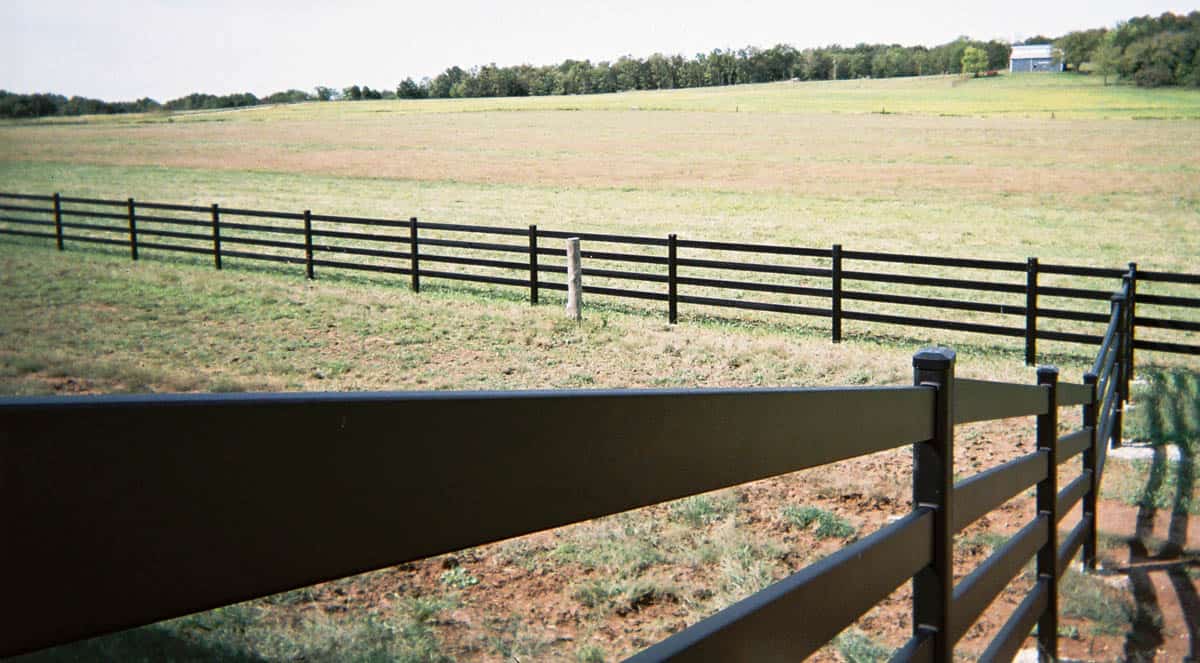There’s an old saying in ranching that measuring twice and cutting once saves more than just lumber—it saves headaches. When it comes to calculating how many fence posts you need for your property, that wisdom hits home harder than a mustang testing a weak fence line.
Truth is, getting your post count right isn’t just about the math—though that’s part of it. It’s about protecting your investment, your horses, and your peace of mind. Whether you’re fencing in five acres or fifty, there’s more to consider than just dividing your total footage by standard post spacing. Terrain changes, corner bracing, gates, and paddock divisions all play their part in the final tally.
We’ve spent decades helping folks like you get these calculations right, and we’ve learned that every property tells its own story. Some have rolling hills that need special attention, others have soft spots that demand extra reinforcement. Here at Buckley Fence, we understand that proper planning prevents poor performance—and we’re here to help you get it right the first time.
The Basics of Calculating Your Fencing Needs
Let’s start with what you already know—a fence is only as good as its posts. You’ve seen it yourself: when posts are properly set and spaced, a fence line stands straight and true for years. When they’re not, well, we’ve all seen those sagging fence lines that look more like a snake’s trail than a property boundary.
Standard spacing for horse fencing typically runs 8 to 10 feet between posts, but that’s just the textbook answer. Real-world experience tells us it’s not quite that simple. Your horses might have different ideas about what that fence needs to handle—whether they’re prone to leaning, testing boundaries, or using your fence line as a scratching post.
One mistake we often see folks make is trying to stretch their post spacing too far. Sure, you might save a few dollars up front, but when you’re out there in February fixing a sagging line because the spacing was too wide, those savings won’t feel like much of a bargain.
Corner Posts
Think of them like the corner posts of a barn—they’re doing the heavy lifting. Skimp here, and you’ll pay for it later. Corner posts need to be bigger, deeper, and properly braced to handle the tension from both directions.
Straight Runs: Not as Simple as They Look
Even on flat, straight stretches, consistent post depth matters as much as spacing. A post that’s two feet deep might hold for a season, but three feet or more gives you the kind of stability that lets you sleep easy during spring thaws and summer storms.
Gate Posts: The Heavy Lifters
Gates deserve special attention. The posts supporting your gates are doing more work than any others in your fence line. They’re supporting dynamic weight that moves and shifts every time that gate swings. We typically recommend posts that are at least 6 inches in diameter here, set deeper than your line posts.
How Many Fence Posts You Need: Calculation Formula
On paper, calculating fence posts starts with simple division. Take your total fence length in feet, divide it by your post spacing (typically 8-10 feet for horse fencing), and add 1. So for a straight 100-foot run with 8-foot spacing, you’d need about 14 posts:
(100 ÷ 8 = 12.5, round up to 13, add 1).
For those who like their numbers straight up, here’s a starting point for standard spacing:
- 100 feet: 13-14 posts
- 200 feet: 26-27 posts
- 400 feet: 51-52 posts
- 1 acre square (209 feet per side): 106-110 posts
Let’s say you’re fencing a 2-acre paddock. Sounds straightforward, right? But let’s walk through it together:
- Perimeter: Roughly 1,040 feet (if square)
- Basic post count at 8-foot spacing: 131 posts
But hold on—now we need to account for:
- 4 corners (each needing 3 posts for proper bracing)
- 1 gate (requiring 2 heavier posts)
- That low spot in the back corner (needing closer spacing)
Suddenly, your actual count is closer to 145 posts. That’s why we say the formula is just the starting point.
This is where having a partner matters. When you work with us, we don’t just plug numbers into a calculator. We note those spots where the ground dips, mark where you’ll need extra bracing, and account for your specific needs. It’s the difference between a rough estimate and a plan you can count on.
Factors That Affect Your Post Count
Every piece of land tells a story, and that story directly affects your post count. That gentle slope might look subtle to the eye, but it can demand significant adjustments to your post spacing. Same goes for that rocky outcrop or that spot where water tends to pool after a good rain. Let’s break down what you need to consider.
Terrain Changes
- Slopes and Hills: When you’re fencing uphill or downhill, you’ll need more posts than what your basic math suggests. That 8-foot spacing might need to shrink to 6 feet on steeper slopes—and sometimes even closer. It’s not just about keeping the fence straight; it’s about maintaining tension and stability when gravity’s working against you.
- Rocky Ground: Hit rock, and you’ve got decisions to make. Sometimes you’ll need to shift a post location slightly, which affects your spacing on both sides. Other times, you might need to add concrete or adjust your depth. Either way, your post count often increases to maintain proper support.
- Low or Wet Areas: That spot where the ground stays soft after rain? You’ll want closer post spacing there, maybe even some extra reinforcement. We’ve seen too many fences start to lean in soft ground to take chances with standard spacing.
Design Elements That Change the Count
Each gate needs:
- Two extra-sturdy posts (usually 6″ diameter minimum)
- H-braces on both sides
- Closer post spacing leading up to the gate Count on adding 4-6 extra posts per gate beyond your basic calculation.
Every corner in your fence line needs:
- Three-post bracing assemblies
- Closer spacing approaching the corner
- Additional support based on tension direction
- A 90-degree corner typically adds 3-4 posts to your count.
Anywhere horses gather regularly—like around water troughs or run-in sheds—plan on:
- Reducing post spacing by 25-30%
- Using heavier posts
- Adding extra bracing where needed
If you’re fencing an arena, those corners take extra attention:
- Tighter post spacing (usually 6 feet or less)
- Additional bracing
- Potentially doubled posts in high-stress points
Advanced Fence Planning Considerations
When you’ve been in this business as long as we have, you learn that good fence planning is a lot like good horsemanship—it’s about anticipating needs before they arise. Sure, we could just run a straight line and call it done, but that’s not how we operate. Your fence line needs to work as hard as you do, day in and day out, through every season and situation.
- Horse Behavior: Your horses’ habits shape your fencing needs. If you’ve got playful yearlings who love to test boundaries, or stallions that need serious separation, adjust post spacing and bracing accordingly. Even those horses that love using your fence line as their personal scratching post—plan for that.
- Seasonal Changes: What works in August might not cut it in March. Account for frost heave in winter, ground softening during spring thaw, and how drainage patterns shift throughout the year. This often means additional posts in strategic locations to maintain stability year-round.
- Future Expansion Plans: Maybe you’re starting with two horses but planning for four. Or you might want to add an arena down the line. Smart planning now saves you money later—build in junction points and plan for future gates where you’ll need them.
- Equipment Access: Those big round bales need to get in somehow, and your tractor needs room to maneuver. Consider equipment access points and maintenance paths in post planning to guarantee your daily operations run smoothly.
- Pasture Rotation Needs: Good grazing management requires flexibility. Pan your post layout to accommodate temporary divisions and rotation patterns, giving you options for managing your grass through all seasons.
- Natural Gathering Points: Horses are creatures of habit. They’ll have their favorite spots to gather—usually wherever you’d rather they didn’t. Reinforce these areas with additional posts and proper bracing, saving you maintenance headaches down the road.
- Local Wildlife Patterns: Whether it’s deer pressure or other wildlife concerns, account for these natural factors in post spacing and placement. Sometimes an extra post or two in the right spot can prevent bigger problems later.
- Long-Term Property Value: A well-planned fence line doesn’t just serve your immediate needs—it adds value to your property. Consider sight lines, aesthetics, and durability in every post you place.
Working with Buckley Fence to Plan Your Fencing
We believe a good fence starts with good planning, and good planning starts with a conversation. We’re not just here to sell you posts and rails—we’re here to help you build something that’ll stand the test of time, weather, and whatever your horses throw at it.
When you work with us, you’re tapping into decades of experience that goes beyond basic calculations. We get to know your specific needs and help you plan for challenges you might not have considered. Our team has seen just about every fencing situation you can imagine, and quite a few you probably can’t.
Ready to get started? Here’s how we make it simple:
- Give us a call or drop us a line
- We’ll schedule a time to discuss your needs
- We’ll help you work through all the calculations and considerations
No more wondering if you’ve ordered enough posts or if you’ve accounted for everything. No more second-guessing your measurements or worrying about that tricky slope in the back pasture. Just straight talk, solid planning, and the peace of mind that comes from knowing your fence line is in good hands.
Because at the end of the day, a fence isn’t just about keeping horses in—it’s about keeping your peace of mind intact. Let’s build something worth building. Together.



